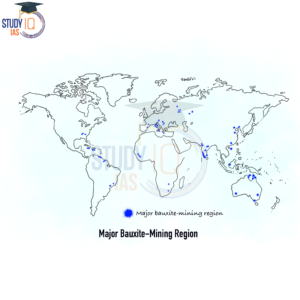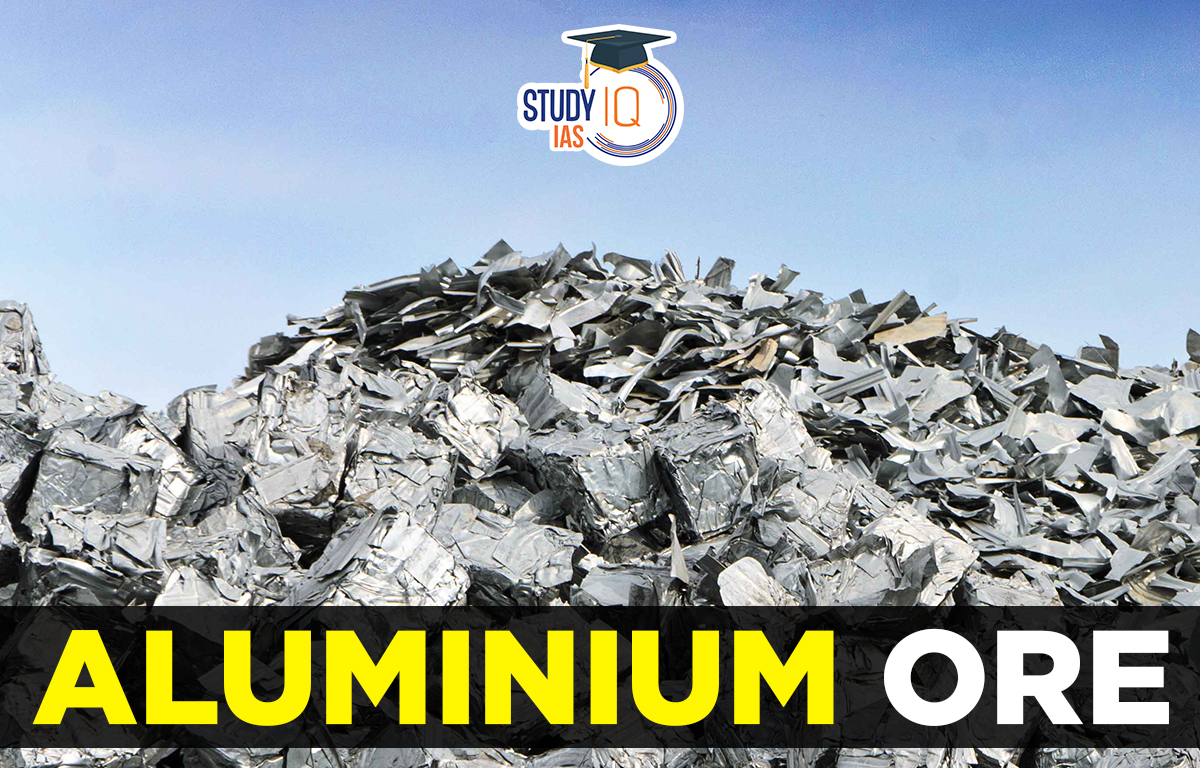Table of Contents
In 2023, India is the fifth-largest producer of bauxite in the world, with a 0.67% increase in output compared to 2022. From 2018 to 2022, production grew at an average rate of 0.15%, and it is expected to rise by 3% each year from 2023 to 2027. India produces 6% of the world’s bauxite, with the biggest producers being Guinea, Australia, China, and Brazil. In 2023, bauxite exports from India also increased by 0.67%, mainly going to Nepal. India’s bauxite exports are predicted to grow at an average rate of 3.33% from 2023 to 2027.
Aluminium Ore
Bauxite is the main ore for aluminum, with nearly all aluminum produced from it. Bauxite is not a mineral it’s a rock made mostly of aluminum-bearing minerals and forms when laterite soils lose silica in wet climates. Its composition varies, including hydrous aluminum oxides and clay minerals. Bauxite is soft and usually white to gray, sometimes stained by iron. It has an earthy luster and low specific gravity (2.0 to 2.5).
To produce aluminum, bauxite is crushed and purified through the Bayer Process, which uses sodium hydroxide to extract aluminum. The aluminum hydroxide is then heated to form alumina, which is smelted using the Hall-Heroult Process, requiring a lot of electricity. Most aluminum in the U.S. is produced in Canada, where electricity costs are low.
Read More: Copper Ore
Aluminium Ore Bauxite Mining
Aluminium Ore Bauxite (raw material) is bulky, and it is preferable to remove moisture and impurities before transporting its ore over long distances in order to achieve economic production. It takes 6 tonnes of bauxite to produce 1 tonne of aluminum. The aluminum industry is energy-intensive, with power costs making up 30-35% of total expenses, so affordable electricity is essential.
There is a shortage of primary aluminum to meet rising demand, which has increased by over 1 million tonnes a year, while production stays steady at about 0.5 million tonnes. Since this industry needs lots of power, finding suitable locations in India is challenging.

Read about: Iron Ore
Aluminium Ore Distribution in World
Most bauxite deposits are located in tropical and subtropical regions. There are many rocks in these regions that are rich in aluminum silicates. Australia, China, and Guinea are the top three bauxite-producing countries.
| Country | Areas |
| Australia | Weipa, Cape York Peninsula. |
| China | Shanxi, Shandong Henan, Guizhou, Guangxi, and Yunnan |
| Guinea | Fria |
| USA | Arkansas, Alabama, Georgia |
| CIS | Urals, Turgay |
| France | Brignoles |
| India | Bihar |
| Australia | Weipa, Cape York Peninsula. |
Read More: Manganese Ore
Aluminium Distribution in India
1. Odisha
Odisha is India’s largest bauxite-producing state, accounting for more than half of total production. The state’s total recoverable reserves are estimated to be 1,370.5 million tonnes. The main bauxite belt is in the districts of Kalahandi and Koraput, and it extends into Andhra Pradesh.
2. Jharkhand
Jharkhand has been estimated to have 63.5 million tonnes of recoverable bauxite reserves of all grades. These reserves are spread across Ranchi, Lohardaga, Palamu, and Gumla districts. Bauxite can also be found in the districts of Dumka and Munger. Lohardaga and surrounding areas have high-grade ore.
3. Maharashtra
Maharashtra accounts for approximately 10% of total bauxite production in India. The state’s total recoverable reserves are estimated to be in the order of 87.7 million tonnes. The largest deposits are found in the Kolhapur district, where the plateau basalts are capped. In the Kolhapur district, rich deposits with alumina content ranging from 52 to 89 percent can be found in Udgeri, Dhangarwadi, Radhanagari, and Inderganj.
4. Chhattisgarh
Chhattisgarh produces more than 6% of India’s bauxite. The Maikala range in Bilaspur, Durg districts, and the Amarkantak plateau regions of Surguja, Raigarh, and Bilaspur have rich bauxite deposits.
5. Madhya Pradesh
The main producers in Madhya Pradesh are the Amarkantak plateau area, the Maikala range in the Shahdol, Mandla, and Balaghat districts, and the Kotni area of Jabalpur district. Andhra Pradesh (Vishakhapatnam, East Godavari, and West Godavari), Kerala (Kannur, Kollam, and Thiruvananthapuram), Rajasthan (Kota), Uttar Pradesh (Banda, Lalitpur, and Varanasi), Jammu and Kashmir (Jammu, Poonch, and Udhampur), and Goa also have some bauxite.
Read about: Chromium Ore
Aluminium Advantages
- Aluminium is a versatile metal that has several advantages, including being lightweight and flexible.
- It can be cast, melted, formed, machined, and extruded into a variety of shapes and then fabricated to suit a wide range of applications.
- Because of their lightweight, corrosion resistance, and ease of fabrication, aluminium sheets are the preferred material for projects such as vehicle panelling, artwork, building cladding, and kitchen fitting, among others.
- Despite popular belief, aluminium is completely recyclable and retains all of its original properties during the recycling process.
- Using recycled metal during production is more cost-effective than using prime metal mined from the ground, so as much recycled material as possible is used.
Read More: Cobalt Ore
Aluminium Uses
- It is used in manufacturing aircraft, automobiles, rail wagons, ships, and machinery.
- It is used in the manufacturing of domestic appliances and utensils.
- It is also used to fabricate doors, windows, and screens.
- Aluminium can be rolled into thin sheets called aluminium foils. These are used for wrapping and packaging food.
Read More: Types of Resources
Aluminium Ore Industries
Aluminum’s Importance:
- Critical strategic metal for India’s economy.
- Second most important industry after iron and steel.
Uses of Aluminum:
- Modern electricity production and distribution (good conductor).
- Household utensils and electric appliances.
- Aircraft manufacturing and rail coaches.
- Nuclear and defense equipment.
Growth:
- Fastest-growing metal, nearly 20 times growth in 60 years (compared to 6-7 times for other metals).
- Created over 800,000 jobs in related sectors and over 4,000 small and medium enterprises (SMEs).
Bauxite Reserves:
- India ranks seventh in the world for bauxite reserves, the primary raw material for aluminum.
National Mineral Exploration Trust:
- Established to boost aluminum production and ensure raw material availability for industries.
Read about: Energy Resources
Aluminium Ore UPSC
Aluminium, a lightweight silvery-white metal, is the most abundant and one of the least expensive metals on the planet. The Indian aluminium industry is highly concentrated, with India ranking second in the world in terms of output. It accounts for nearly 5.3 per cent of global aluminium output, with the top five companies accounting for the vast majority of output. Despite rising demand, India’s aluminium industry is thriving at a breakneck pace. This article will explain the Aluminium Industries, which will help you prepare for the UPSC Civil Service Exam in Geography.
Read More: Minerals


 Indus River System, Tributaries, and Sin...
Indus River System, Tributaries, and Sin...
 Jallianwala Bagh Massacre, Date, History...
Jallianwala Bagh Massacre, Date, History...
 Important Lakes of India, State wise and...
Important Lakes of India, State wise and...






















